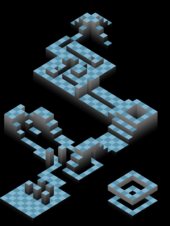
Back مستوى (لعبة فيديو) Arabic Nivell (videojocs) Catalan ئاست (کایەی ڤیدیۆیی) CKB Level (úroveň) Czech Level (Spielabschnitt) German Nivel (videojuegos) Spanish لول (بازیهای ویدئویی) Persian Kenttä (videopeli) Finnish Niveau (jeu vidéo) French Level (permainan video) ID
This article has multiple issues. Please help improve it or discuss these issues on the talk page. (Learn how and when to remove these messages)
|

| Part of a series on the |
| Video game industry |
|---|
In video games, a level (also referred to as a map, mission, stage, course, or round in some older games) is any space available to the player during the course of completion of an objective. Video game levels generally have progressively increasing difficulty to appeal to players with different skill levels.[1] Each level may present new concepts and challenges to keep a player's interest high.[1]
In games with linear progression, levels are areas of a larger world, such as Green Hill Zone. Games may also feature interconnected levels, representing locations.[2] Although the challenge in a game is often to defeat some sort of character, levels are sometimes designed with a movement challenge, such as a jumping puzzle, a form of obstacle course.[3] Players must judge the distance between platforms or ledges and safely jump between them to reach the next area.[4] These puzzles can slow the momentum down for players of fast action games;[5] the first Half-Life's penultimate chapter, "Interloper", featured multiple moving platforms high in the air with enemies firing at the player from all sides.[6]
- ^ a b Schell, Jesse (2014). The Art of Game Design: A book of lenses. Pittsburgh, Pennsylvania, USA: CRC Press. pp. 120, 252. ISBN 978-1-4665-9864-5. Archived from the original on 8 February 2023. Retrieved 30 December 2017.
- ^ McGuire, Morgan; Jenkins, Odest Chadwicke (2009). Creating Games: Mechanics, Content, and Technology. Wellesley, Mass.: AK Peters. p. 104. ISBN 978-1-56881-305-9.
- ^ Jamie "Thrrrpptt!" Madigan (June 2001). "Half-Life: Blue Shift". Archived from the original on December 16, 2008. Retrieved 2009-04-02.
- ^ Andrew Park (2002-10-11). "Batman: Vengeance Review". GameSpot. Archived from the original on 2011-08-09. Retrieved 2009-04-02.
- ^ Kevin VanOrd (2008-11-11). "Mirror's Edge Review". GameSpot. Archived from the original on 2011-10-26. Retrieved 2009-04-02.
- ^ "Chapter XVII: Interloper". GameSpy. Archived from the original on 2011-08-08. Retrieved 2009-03-27.